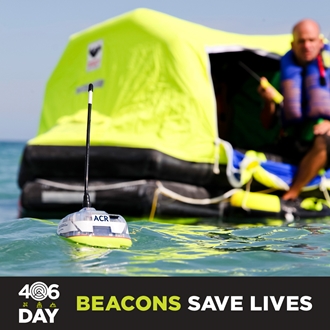Marine safety specialists ACR Electronics and Ocean Signal are launching 406Day on 4/06 (4th June) this year.
406Day aims to raise beacon awareness across the world by reminding boaters about the importance of life-saving 406 MHz technology and by providing advice about the benefits and responsibilities of owning a 406 MHz beacon such as a PLB (Personal Locator Beacon) or EPIRB (Emergency Position Indicating Radio Beacon).
Celebrated on April 6th as a national awareness day in the US since 2013, #406Day18 has been hugely successful in shining a spotlight on beacons for the last five years and is now officially recognised as a state-wide day in ACR Electronics’ home state of Florida.
Now ACR, Ocean Signal and their safety partners and supporters are aiming to promote beacon ownership, as well as highlight safety checks and maintenance procedures, throughout the rest of the world on the easy-to-remember annual date on 4th June. Helping people understand how to register, use and test their beacons correctly, the day is also a celebration of the over 41,000 lives saved by using 406 MHz beacons and the COSPAS-SARSAT Satellite system.
James Hewitt, Sales and Marketing Manager, Ocean Signal, said: “406Day is a really good opportunity to highlight some important safety checks and procedures for beacon owners. EPIRBs, for the vessel, and PLBs, which are registered to a person, are a fast and effective way to send an alert and enable the search and rescue authorities to identify and locate a casualty. However, it is vital that these essential safety devices are properly registered and maintained so that the beacons can be relied upon to function correctly when activated. 406 MHz signals save lives, but it is a technology that requires responsibility.”
406 MHz technology
EPIRBs and PLBs operate on the 406 MHz frequency. Each 406 MHz beacon transmits a unique digital code that identifies the type of beacon and allows registration data to be associated with the beacon. The registration data provides information such as the beacon owner, the type of vessel and emergency points of contact.
- ACR Electronics and Ocean Signal offer the following checklist to serve as a reminder to check expiration dates and ensuring correct registry:
- Is your EPIRB registered?
- When was your EPIRB last tested/serviced?
- Is your EPIRB programmed?
- What is the battery life of your EPIRB and when does it need to be replaced?
- Do you know how to self-test your EPIRB to ensure it is working correctly?
To help answer the questions, the following advice is provided to ensure best practice for beacon ownership:
Register and update your 406 MHz beacon registration
All beacon owners should register their device with the appropriate authorities. UK users of EPIRBS and PLBs should register their details on the UK Beacon Registry at www.gov.uk/406beacon. This free and simple registration will speed up a rescue and provide Search and Rescue with information about you and your vessel which is vital in an emergency. In other countries contact your local authority. Details can be found at www.406registration.com/countriessupported.aspx.
Check your 406 MHz beacon battery expiration dates
Users must check the expiry dates to ensure the EPIRB or PLB will function correctly when required in an emergency. When selecting your beacon, key considerations include the added convenience of user replaceable batteries and the reassurance of a long battery operating life. Ocean Signal leads the industry in these areas of innovation. The SafeSea E100G EPIRB features user replaceable batteries with a five-year replacement interval. The rescueME PLB1, meanwhile, has a seven-year battery life. The rescueME EPIRB1 has even longer battery life at a massive ten years between routine replacements.
Test your 406 MHz beacon
You should test your EPIRB using the ‘self-test mode’ once a month to monitor the 406 MHz RF power, as well as the 121.5MHz homer RF power, synthesiser lock and battery voltage under load. Ocean Signal also recommends regular inspection to ensure: no obvious signs of damage, including the state of the antenna; secure mounting on the bracket or float free housing; the lanyard is not attached to any structures; the HRU (Hydrostatic Release Unit) in the case of a float free housing is within the specified expiry date; the EPIRB and mounting is cleaned, only using a damp cloth. It is also recommended to carry out routine testing of your PLB to ensure it is in good working order, using the specified ‘Test’ key. Ocean Signal suggests you do not test the GPS receiver more than once a year as it expends significant amounts of battery energy.
Everyone is encouraged to join the conversation and help spread the word about beacon use by adding #406Day18 when posting on Facebook, Instagram, YouTube or Twitter.
Visit ACR’s SurvivorClub (You use it - we replace it program) and Ocean Signal’s Rescue Stories to see real life testimonies shared by people of all ages and from all walks of life, who thanks to their beacon, have lived to tell the tale.
Ocean Signal’s UK distributor Ocean Safety offers visual inspection and test sequence check of all leisure beacons at their four UK branches. For information about the full range of products available from Ocean Signal, please go to www.oceansignal.com.






